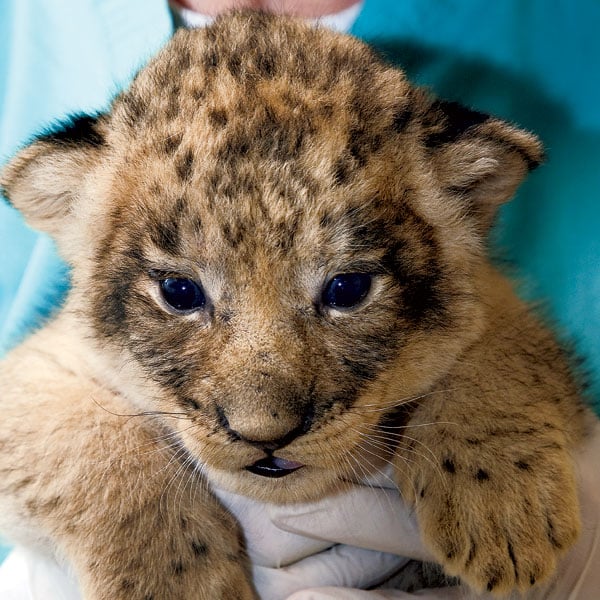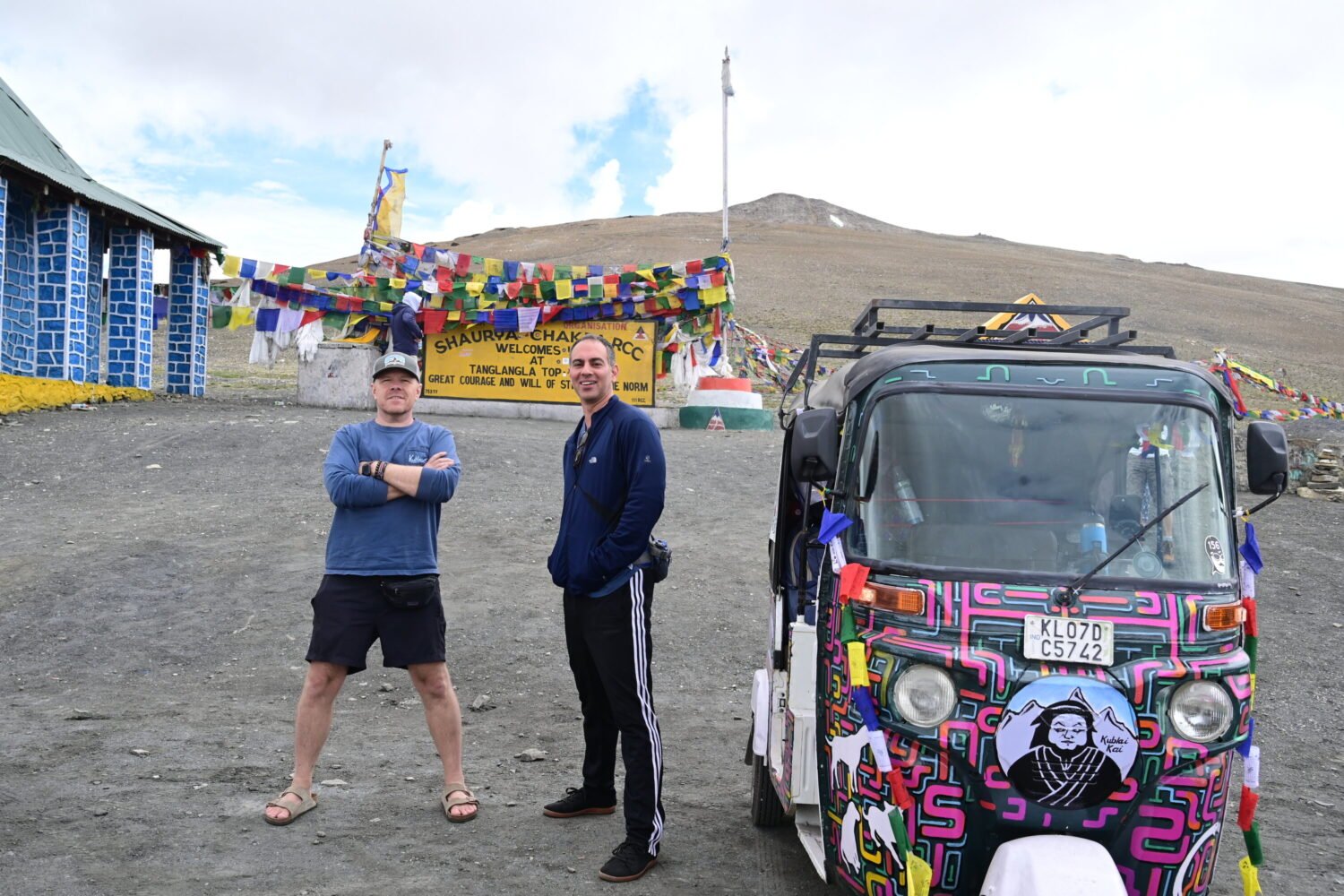Rebecca Stites lay on her sofa and stared at her laptop. An animal keeper at the National Zoo, Stites was plugged into a live video feed of a cubbing den—a small room with a concrete floor, cinderblock walls, and an adjoining caged area—where Shera, one of the zoo’s two female lions, was giving birth.
Though even zoos in smaller cities such as Norfolk and Tulsa had had lion cubs in recent years, the National Zoo hadn’t had any in more than two decades. The zoo currently doesn’t have many crowd-pleasing big animals—no giraffes, rhinos, or hippos. Baby animals are always a big draw, and lion cubs could help make up for the departure of the beloved panda Tai Shan.
Stites was a key member of the team that had been working for two years to build a lion pride and produce cubs. She felt powerless watching the birth from home, but there was nothing more she or any other zoo staffer could do. None of them would be present for the birth.
Stites had logged onto the video feed around 7 pm on August 30 of this year and noticed that Shera looked as if she couldn’t find a comfortable position—a sign she would probably go into labor soon. Now, five hours later, there were two cubs—two fuzzy, clumsy little fur balls—in the den with her, and it didn’t appear that she was finished.
Stites watched as Shera stood up, circled, and dropped a third cub. Stites had never seen the actual moment of a cub’s birth. As number three lay motionless on the bed of hay and pine shavings, Stites exchanged nervous text messages with her boss, Craig Saffoe, who was also watching from home. This didn’t look good, they wrote each other. Why wasn’t the cub moving?
Early in Shera’s pregnancy, the zoo’s new director, Dennis Kelly, had proposed streaming real-time video of the birth to the public. Moments like this were a reminder of why the zoo staff had persuaded him not to. Though cubs in captivity have higher survival rates than in the wild, about a third die before their first birthday. Any number of things could go wrong. Shera might reject her cubs and refuse to nurse. She could get startled and swat at them with her saucer-size paws. If they’re stillborn or if Shera gets stressed, she might even eat them. How would people watching at home—and there was little doubt they would want to watch—react to that?
Stites already knew the disappointment—a feeling she describes as getting the air knocked out of her—of losing a newborn cub. She held her breath, willing the animal to live. Come on, she thought. Move.
With all the time the keepers spend with the lions, they can’t help getting attached. Even Janine Brown, head of the zoo’s endocrinology lab and an elephant expert, feels a bond with animals whose hormones she studies. “They are part of my family,” she says, “but I’ve never seen three-quarters of them.”
Stites and Kristen Clark, another keeper, have been taking care of the zoo’s three lions—Shera, her sister Naba, and Luke, the cubs’ father—for several years. The lions came to the National Zoo in 2006 from South Africa, where they were born in a private reserve. At the time, the National Zoo had just one lion, a 16-year-old female named Lusaka who’d been spayed.
Part of the keepers’ job was to train the lions so keepers could check them for health problems without using anesthesia. It was a slow process, but the lions caught on: Do something right, get a treat. The rewards included raw meatballs, whole rabbits, and the lions’ favorite, knuckle, femur, or shank bones from cows.
Luke, Shera, and Naba learned to open their mouths so the keepers—standing on the other side of the cage door—could inspect their teeth, to step on a scale, to give the keepers a view of their bellies, to sit still while the keepers pricked them with a needle. Getting such powerful animals to do what you want, to trust you enough to let you inflict discomfort—it’s a good feeling. The keepers think about the lions all the time, talk about them, even dream about them.
And sometimes it seems as if the lions return their affection. Luke, Shera, and Naba rub their heads against the mesh cage doors when Clark and Stites speak to them, and the animals often spot them in the public viewing area and follow them with their gaze as they walk through the crowd.
But Clark and Stites have to assume their love is unrequited. To think otherwise about a big cat could be deadly. In 2007, a keeper at the San Antonio Zoo forgot to lock a series of gates behind him and was attacked by a Sumatran tiger, who bit him several times and dragged him by the head, almost killing him. The same year, a keeper at the Denver Zoo entered a jaguar’s cage and was mauled to death.
Saffoe makes a point of checking on his staffers each morning. If they’re not totally focused, he puts them on office work. He likes to remind them of his rules: Don’t get complacent. Always know where the cats are. Always know where your colleagues are.
Because of the danger, keepers never go into the same space as an adult lion, which is why they wouldn’t be able to rescue a newborn cub if something were to go wrong.
It wasn’t love at first sight for Shera and Luke. Naba is the boy-crazy sister, according to Clark, “the pretty one who likes to have sex.” Shera is the smart one, who’s quick to find the toys keepers leave in the yard—things like empty beer kegs and pieces of fire hose—and who picks up training easily. She took longer to show interest in Luke.
Instead of courting, what lions do in the wild looks more like rape and pillage. At around age two, males leave their mothers and band together with a couple of brothers, cousins, or other males. Then they roam around searching for a vulnerable pride to take over. If they succeed, they kill or drive off their rivals, kill all the cubs, mate with the females, and claim the pride’s hunting territory.
When introducing lions in captivity, zoo staffers have to pay attention to the social dynamics. Put the wrong combination of lions together, or put them together too quickly, and they might kill one another.
Luke and the sisters weren’t introduced until they arrived in Washington. The first time they were all out in the lion yard together, Saffoe closed the area to spectators. Saffoe, Stites, and Clark watched from the public viewing area, where a member of the zoo’s police unit stood ready with a shotgun. If things got out of control, the officer could pelt one lion with beanbags or rubber bullets and give another a chance to escape.
Luke had more than 100 pounds on Naba and Shera and could easily kill either of them, but the sisters might double-team him. The keepers didn’t expect a big fight; the lions had already spent time together indoors and seemed well on their way to forming a pride.
Luke went into the yard first. When Naba and Shera entered, Luke and the girls seemed surprised to see one another and started growling and circling. The zoo staffers looked on nervously as roars grew louder and the lions bared their teeth. Naba and Shera got on either side of Luke. Knowing how little control they had, Saffoe, Clark, and Stites stood on their tiptoes and held their radios up. “That makes you feel like you’re doing something,” Clark says.
Luke pinned Naba, but she quickly escaped and got on top of him for a split second. Then, after about six minutes, it looked as if the group had worked out whatever they needed to, and they lay down. “It was the most nervous six minutes I’ve ever had,” Clark says.
Inside, Naba had intimidated Luke. At 3½, Luke was an adult, but in some ways he still acted like a cub, showing more interest in the keepers than in the other lions. When he and Naba were put together in a cage in the labyrinthine space beneath the lion/tiger yards, Naba, in heat, rolled around and threw herself on the ground—a not-so-subtle sign that she was interested in mating. She even tried crawling under him, but Luke spent most of the encounter hiding under a bench and biting his tail like the Cowardly Lion from The Wizard of Oz.
But he eventually got the idea. The next time Naba went into heat, about two weeks later, she and Luke met again. He hid under the bench for several minutes, but then he crept out and sniffed around Naba. “He’d take a little nibble at her neck and then back off,” Saffoe says. “And then he’d look at us almost as if to say, ‘Really? I’m allowed to do that?’ ”
Sarah Putman was the first to know that Naba was pregnant. Putman, a technician in the endocrinology lab at the Smithsonian Conservation Biology Institute in Front Royal, had been tracking the hormones of Naba, Shera, and Luke—as well as hormones from lions at zoos across the country—since 2007.
The keepers collect fecal samples from the lion yard every day. To tell whose poop is whose, they add green peas to Naba’s food, black-eyed peas to Shera’s, and rice to Luke’s. Other zoos use edible glitter or cake dye.
The keepers label the samples and put them in a freezer. Then they overnight batches of samples via FedEx to Front Royal, where Putman freeze-dries the poop, pounds it with a rubber mallet, sifts it, mixes it with alcohol, boils it for 20 minutes, dilutes it, and finally measures the hormone levels in it.
Putman, a graduate student at George Mason University, is working on a thesis about African lion reproduction. There has been little research on the topic because lions are relatively easy to breed in captivity. Pandas have only a 24-to-48-hour window when they can be artificially inseminated. Putman once stayed awake for nearly 48 hours checking the hormones in Mei Xiang’s urine every time the panda peed. Even tigers—which are nearly identical to lions anatomically—are trickier; because they’re solitary creatures, males and females have to be brought together at exactly the right time. With lions, once a pride is established, they live together year-round.
In the 1990s, zoos accredited by the Association of Zoos & Aquariums had a moratorium on breeding lions. Many of the lions had unknown pedigrees, and scientists worried about inbreeding. Zoos spayed their females or put them on contraceptives—through injections or implants—and brought in about 50 new lions from southern Africa, where conflicts with people often lead to orphaned cubs.
African lions are doing better in the wild than tigers and other large cat species, but their numbers have been falling. The International Union for Conservation of Nature categorizes the species as “vulnerable,” which is slightly better than endangered and means there’s a high risk of extinction.
The newcomers were ranked according to the diversity they brought to the gene pool. As of this summer, Luke was the most valuable lion at the AZA zoos because he had the fewest relatives; Shera and Naba were tied for second.
When zoos lifted the moratorium in 1998, they expected to see a surge in lion births. But when the baby boom didn’t materialize, scientists started to take a closer look at lion reproduction.
About six years ago, the problem seemed to resolve itself and cubs were scampering around zoos. It’s not entirely clear what led to the success, but experts believe it was in part a matter of enough keepers getting experience breeding lions.
Looking at Naba’s hormone samples, Putman saw a spike in progesterone that corresponded with her mating with Luke on January 27. Such a spike doesn’t automatically mean cubs are on the way. In humans, progesterone levels return to normal after ovulation if a woman isn’t pregnant, but in lions they can stay elevated for about 50 days.
There’s some disagreement among scientists about whether this phenomenon is a true pseudopregnancy. The term means that an animal displays all the markers of a pregnancy without actually being pregnant. When pandas have pseudopregnancies, they cradle an object as they would a baby. But lions don’t change their behavior much when they’re pregnant.
Putman tested the hormones for the first 55 days after Naba mated with Luke. It took about a week, but the results showed that her progesterone levels had stayed high. Saffoe and his team started preparing for one to six cubs.
It was an emotional year for Clark and Stites. Lusaka died in January, and there were other deaths among the animals they cared for—a Sumatran tiger, a fishing cat, and a white-nosed coati, a relative of the raccoon. Though all were elderly, it was hard to say goodbye.
Naba’s cub was born around 4 am on May 18. For 2½ days, everything appeared to be going well. Naba groomed and nursed the cub, and the zoo opened the cub cam for public viewing.
For Saffoe, the emotions leading up to the birth were similar to those surrounding the arrival that same month of his own firstborn, a son. The same joyful anticipation, the same nail-biting nerves.
Saffoe was at work on May 20 preparing for ZooFari, an annual event with food tastings and animal demonstrations, when he got a call from a woman in the zoo’s communications office. She’d been watching the cam and noticed that the cub wasn’t moving. “I remember saying the cub is probably asleep,” Saffoe says. But he decided to check.
When Naba went into the adjacent outer cage, Saffoe and Stites closed the door that connects it to the cubbing den and went inside. Saffoe unplugged the cam, not knowing that it would leave viewers for hours with a frozen image of the dead cub.
Afterward, Stites watched the footage over and over, searching for clues. “It looked like it had just lain down to go to sleep,” she says. Clark wondered if Naba had accidentally rolled over on the cub, but an exam revealed that the newborn had inhaled a hay awn—a small pointed tip on a piece of hay—and contracted pneumonia.
“Naba had done everything right, and that made me feel even worse for her,” says Clark, holding back tears even months later. “It was just this totally random thing that happened. She was a good mom.”
In the wild, a lioness will fight to the death to protect her cubs. But she’ll also abandon them if food is scarce. It’s impossible to know what Naba felt after her cub died. Mother elephants have been seen holding vigil over a dead calf, and gorillas carry dead babies in their arms for days or weeks. But Naba didn’t show any signs of grief.
There’s a moment in the footage when she grooms the cub, and when it doesn’t move, she gets up and leaves the inner den. Clark and Stites think she seemed confused.
The cub died sometime between 4:30 and 5 pm. By 5:12, cam watchers started posting questions on the zoo’s Facebook page. “What’s wrong with the baby lion?” the first one asked.
When the announcement went out the next day, it was met with a mixture of heartbreak and outrage. “I am sitting at work in tears!” one person wrote. Many sent their condolences to the keepers, but others charged that the zoo staff should have foreseen the danger in using hay for bedding—though that’s standard practice—and cited an example of a newborn polar bear that died the same way.
Dennis Kelly, who came to Washington from Zoo Atlanta, says people in this well-educated area pay especially close attention to what goes on at the National Zoo, and when something happens that they don’t like, he hears about it. Some blame the zoo even when an animal dies of natural causes, often harking back to the institution’s record of seemingly preventable deaths during Lucy Spelman’s tenure as director, from 2000 to 2004.
“Another one in the long, sad saga of the animals the National Zoo has killed through neglect and incompetence,” someone wrote in the online comments of a Washington Post story about Naba’s cub. One person called the zoo “animal Auschwitz.”
The outpouring over Naba’s cub was a reminder that people don’t go to zoos to see nature, that what they want is to get a glimpse of the wild without any of its grim realities.
Another reminder of that fact came on a busy Sunday afternoon last November when a deer jumped into the lion yard. Naba and Shera were outside. When they attacked, the crowd that had been admiring them gasped in horror and cheered for the deer, which put up a surprisingly good fight and escaped into the deep end of a moat in the lion yard.
After the keepers got both lions indoors, the deer climbed out of the water and collapsed. A necropsy revealed that the lions’ claws had sliced through its organs without leaving a mark where they went in. Videos of the attack quickly appeared on YouTube.
In the past, the National Zoo waited weeks before announcing animal births because so many newborn animals die. But it’s trying to be more open. In the process, it has had to find a new balance to allow the public to see its inner workings and follow their favorite animals without traumatizing people when something goes wrong.
The same week Naba’s cub died, Shera bred with Luke. Two weeks later, Naba went back into heat and bred with him again.
When Putman confirmed that both lions’ progesterone levels had stayed high for more than 50 days, Saffoe and his team began preparing for two new litters. This time, they’d use a kind of hay with fewer awns and sift through it by hand to remove as many as possible. And they’d wait three days before launching the cub cam, in the meantime offering snippets of video and updates on Facebook, Twitter, and the zoo’s own Web site.
As Stites watched Shera’s third cub on her laptop, she saw a twitch. Then another. And another. Soon the cub was squirming around as if it had suddenly sprung to life.
The next morning, her husband woke before her and refreshed the screen on her computer. Though she’d been up late, he knew she’d want him to wake her with the news. “Congratulations,” he said. “You have a fourth cub.”
A month later, Naba had her own restless night. By then, the cubs were practically visible inside her belly. “Sometimes on the camera you could see these lumps,” Clark says.
Naba didn’t start to toss and turn till around 1:30 am. Zoo staff members set alarms to wake up periodically, but Naba didn’t have her first cub till 8 the next morning. By then, some staffers were gathered in the keepers’ office, cheering on each of the three newborns. Though the cubs were blind—their eyes don’t fully open until they’re around ten days old—and unsteady on their feet, they made their way over to their mother and started nursing within a few minutes of birth.
Excited as the keepers were, they tempered their emotions, knowing that the cubs weren’t yet in the clear. The public showed no such restraint. The Web lit up with their exclamation-point-filled posts.
When the zoo asked participants in a Web chat how much time they spend watching the cub cam each day, 24 percent answered more than four hours. When no cubs were visible on the cam for a week between the two births, the zoo was flooded with questions about when it would go back up.
What was it about that grainy footage—in which nothing happened for long stretches—that so many people found addictive?
The cubs are cute, all fuzzy and wobbly. Scientists say our hard-wired affinity for baby-like traits is so strong, so essential to our survival, that a response is triggered in us even when we look at nonhuman species. Gazing at cute zoo babies with big eyes, button noses, and clumsy movements lights up the parts of our brains that are stimulated by other pleasures like sex and good food.
But the cub cam’s appeal is more than that; it’s a window into a scene we could never otherwise see. Even Craig Packer, an ecologist at the University of Minnesota who has spent 31 years observing lions in the Serengeti, has only rarely witnessed the early days of a cub’s life. As we watch the helpless cubs, toothless and blind, and the tender moments between mother and child, these fierce creatures don’t seem so different from us.
The cub cam gives us a new kind of intimacy with wild creatures, a glimpse—of all things—into the lion’s den.
From his favorite perch at the top of the lion yard, Luke surveys his territory. He seems a different animal from the playful adolescent who came here three years ago. Sometimes he refuses to come inside when he’s called, and he won’t tolerate Saffoe’s presence anymore; if Saffoe comes near him, he jumps up and slams his paws onto the cage door.
Luke hasn’t met his cubs yet. They’ll likely go out in the yard in late fall or early winter and will meet their father whenever their mothers decide to introduce them.
This article initially appeared in the November 2010 issue of The Washingtonian.
Motherhood has changed the sisters. They accept food from Clark and Stites, but Shera hisses and bares her teeth if the keepers come near the cubs. Once the cousins are introduced, probably by Thanksgiving, the mothers may begin to nurse one another’s cubs, as lions do in the wild.
By the time they’re two years old, the cubs will be sent to other zoos to breed and spread their valuable genes. When they’re gone, keepers will put the original trio back together and start over.
The zoo expects big crowds when the seven cubs are out in the yard. For Saffoe, Stites, and Clark, it’s been gratifying to share the process with others, to let people see what they were seeing and answer their questions. Says Clark: “It was sort of like they were experiencing this with us. Sometimes that meant being sad. But we were all watching this for the first time.”

















